I am, right now, typing on my Samsung Galaxy protected by a plastic case that I bought on Canal Street in New York City for $13 this spring. And this replaced the previous protective case I had bought for $34 plus tax at Best Buy last summer.
So I’ve spent a little more than $57 in the past 12 months on plastic phone cases. But this may change.
In the late 1990’s, Napster changed the music industry forever. With one simple click, you could have any song in the world, for free, on your computer, to listen to at home.
And even though Napster didn’t last long, it changed the music industry forever. Something that listeners used to have to purchase in physical form—a CD or cassette tape, for you old-timers—could be digitally shared and listened to.
Today, a new Napster is about to emerge, but this time instead of sharing music, users can share physical, tactile, real manufactured goods via 3D printing.
“If you’re a manufacturer and you see that your product has gotten to the point where it is the same or cheaper to print that product at home as it is to buy it from you, you can go in a couple different directions,” says Storch.
Those two different directions, according to Storch, are to make copying the designs illegal (which he adds is probably unsuccessful in the long run), or to change your marketing strategy and sell them—just like iTunes sells music instead of the music on CDs—just like the 90’s, with the Napster debacle.
But to fully understand 3-D printing and its potential, we need to know about the technology. Commercial 3-D printers began being used in the mid 1980’s. Just about every major industry uses the technology to build prototypes. The reason 3-D printing is being discussed more now is because in the late 2000’s, many key patents expired. Many individuals across the world worked to create open-sourcing for 3-D printing software and hardware.
“Already, people can print structural things: a knee replacement, hip replacement,” Freedman says. “A lot of dentistry is being done with 3D printing.”
“For about five bucks of plastic and another five bucks of wire and screws, you can actually build a functional hand,” he adds.
And just like Napster shook up the music industry, there must be an impact of 3D printing on the manufactured goods sector.
“Now, we can produce consumer-oriented parts or even industry-oriented parts that are one-off and unique and can be produced at very, very low cost with a minimum of material wasted.”
But it’s not just about the consumer economy. The biggest benefits, says Dr. Read, may lie within the manufacturer’s themselves—namely, prototyping:
“I remember, a decade or two ago, talking to an individual who was hired as a prototyper and it would take him weeks upon weeks to do this mock-up, which can now probably be done in an hour or two,” Read says.
And like all inventions, there is a certain amount of economic consequences for supply and demand. In this case, labor currently used in the manufacturing of some of these consumer products may be displaced. But, that’s not necessarily a bad thing. Dr Read again:
“This frees up labor and shows if there is a more efficient, a better way to do something, that labor is then freed up to be used in some place that is more essential in the economy.”
And thesis author Joe Storch agrees with Dr. Read’s vision. Storch says this whole activity of economic change will be swift and compartmentalized through different markets.
“Pretty much the same thing that you can get in the stores–they shift from having a monopoly: where either you get [it] in the stores or you go without–to being as part of a market,” Storch says. “If they continue to charge much more than people would pay printing it at home, then people will choose to print it at home.”
But just like any other disruptive innovation, only time will tell exactly how much I will spend—or where I will obtain—my next Samsung Galaxy case.
02/12/2014
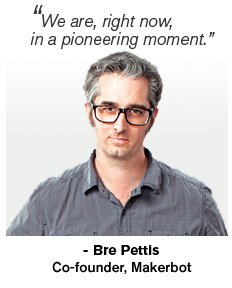 New Paltz celebrated the opening of the nation’s first MakerBot Innovation Center with a press event and ribbon-cutting ceremony on Tuesday, Feb. 11. More than 100 people, including members of the business community, students, faculty and staff, attended the event, which was followed by a lecture by MakerBot CEO Bre Pettis.
New Paltz celebrated the opening of the nation’s first MakerBot Innovation Center with a press event and ribbon-cutting ceremony on Tuesday, Feb. 11. More than 100 people, including members of the business community, students, faculty and staff, attended the event, which was followed by a lecture by MakerBot CEO Bre Pettis.
Pettis’ eagerness and excitement were palpable as he prepared for the ribbon cutting in the Innovation Center. “We were looking for a partner in New York, because New Yorkers just get stuff done,” he said. “It seemed like such a great opportunity. I’m personally really excited to see what happens when the jewelry students join forces with the mechanical engineering students. I want to invest in the company that emerges from the meetings that happen in this room.”
“In many ways, we’re planting a seed here, in very fertile ground, with a lot of enthusiasm, a lot of excitement, a lot of potential energy,” added Pettis, who was described by New Paltz President Donald P. Christian as “the Steve Jobs of 3D printing.”
The event showcased 30 MakerBot Replicator Desktop 3D Printers and scanners, which were actively printing student projects and demonstrating the ease of using the machines as well as the wide range of objects that can be printed. The Center, which will be used by students, faculty, and local industries, will enable rapid prototyping and increase product design cycles. It will also create a forum for increased collaboration and innovation that will help train the next generation of engineers, industrial designers, and artists.
Sean Eldridge, co-founder of the Hudson Valley Advanced Manufacturing Center at SUNY New Paltz and president of Hudson River Ventures, said, “This center is a big win for our region. It will allow more students and small businesses to access this exciting technology, and it will solidify our region’s leading role in using 3D printing technology and training our students and small businesses on its use.”
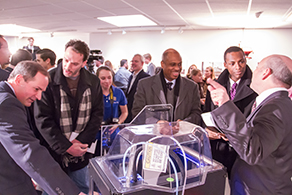
Eldridge said several local businesses are already utilizing 3D printing in the creation of their products, like custom motorcycles from Orange County Choppers; adaptive equipment for disabled individuals from Ulster County-based Rifton; and renewable energy products from Uncharted Play in Poughkeepsie. “There’s no question that 3D printing technology is changing manufacturing forever, and so we must adapt, and we must take advantage of the new possibilities that it offers us,” he said.
President and CEO of Hudson Valley Economic Development Corporation (HVEDC) Laurence Gottlieb, whose daughter is a first-year student at New Paltz, said the HVEDC “takes tremendous pride” in knowing that the 3D printing initiative has “started something quite spectacular here at SUNY New Paltz, and by extension, the entire Hudson Valley.” He also remarked, “We are incredibly proud to be part of this, because what we’ve started is pure magic, and exactly the essence of what good economic development is all about.”

Katherine Wilson ’14 (Metals) answers questions
at the new Innovation Center
Katherine Wilson ’14 (Metals), a graduate student and assistant in the Innovation Center, commented on the opportunities the Center will provide for New Paltz students. “The lab’s most recent addition of MakerBot 3D printers and digitizer 3D scanners is going to make a great impact on the way students learn to use 3D technology,” Wilson said. “With the MakerBot array, students will be able to print their pieces rapidly and gain an understanding of how the printers work. The knowledge that can be acquired from interacting [with] and operating the printers directly, rather than through a third-party manufacturer, is extremely advantageous.”
Paige Munroe ’15 (Metals), a technician assistant in the Innovation Center, said the most frequent question she found herself answering during Tuesday’s event, especially from students, was: “How and when can we start using these?”
The answer is now. “All the students on campus can come in and download a file and print it right away,” said Munroe, who also noted the unbeatable price of printing an object – 5 cents per gram plus a $1 processing fee – which makes the technology even more accessible for traditionally cash-strapped college students. “It’s super cost-effective. It will be really useful for the community outside of just New Paltz, too. Thirty MakerBots is pretty impressive.”
Dean of the School of Science & Engineering Dan Freedman and Interim Dean of the School of Fine & Performing Arts Paul Kassel spoke about how curriculum in both schools will grow to encompass this new technology, and the many opportunities for collaboration that will be made possible by the Center. Central Hudson’s Vice President of Public Relations Denise VanBuren and Vice President of Business Development & Governmental Affairs Anthony Campagiorni were recognized for the key role that Central Hudson has played in New Paltz’s 3D printing initiative and commented on the potential economic impact of this undertaking throughout the region.
“This is the next big step in the development of the College as the leading hub for advanced manufacturing technology in the Hudson Valley region and New York State and I cannot wait to learn what comes next,” said SUNY Chancellor Nancy Zimpher in congratulatory remarks via pre-recorded video.
In his talk, titled “Leading the Next Industrial Revolution,” Pettis discussed MakerBot’s development and the company’s commitment to innovation. Speaking to a standing-room only crowd in Lecture Center 102, made up primarily of students, he talked about the importance of getting outside of one’s comfort zone and trying new things. He sees great potential in the creative ways that students will come to utilize the machines. Pettis is considered the foremost leader in making 3D printing available to educators and consumers.
This partnership between New Paltz and MakerBot is the next chapter in the success story of New Paltz’s already-established 3D printing initiative. The Hudson Valley Advanced Manufacturing Center at SUNY New Paltz was launched in May 2013 with private financial support from Eldridge and Central Hudson. In August 2013, SUNY New Paltz launched its unique certificate program in Digital Design and Fabrication. In December 2013, the Mid-Hudson Regional Economic Development Council and Governor Andrew Cuomo awarded the initiative $1M in state economic development funds.
Archived News
SUNY New Paltz to host grand opening of the nation’s first MakerBot Innovation Center on Feb. 11
02/06/2014
NEW PALTZ - The State University of New York at New Paltz will celebrate the grand opening of the nation’s first MakerBot Innovation Center on Tuesday, Feb. 11, at 11 a.m., in the McKenna Theatre Lobby. The grand opening will be followed by a lecture, titled “Leading the Next Industrial Revolution,” at 2 p.m. by MakerBot CEO Bre Pettis, considered the foremost leader in making 3D printing available to educators and consumers, in Lecture Center 102 on the New Paltz campus.
Intended to be a large-scale 3D printing hub, designed and built in partnership with Brooklyn, N.Y.- based MakerBot, the leading manufacturer of desktop 3D printers, and its knowledgeable engineering, creative, and training teams, the Innovation Center includes 30-plus MakerBot Replicator Desktop 3D Printers and scanners for student, faculty and local industry use. The Center will enable rapid prototyping and increase product design cycles, all the while creating a forum for increased collaboration and innovation that will help train the next generation of engineers, industrial designers and artists.
This partnership is the next chapter in the success story of New Paltz’s already-established 3D printing initiative. Launched in May 2013, with private financial support from Ulster County businessman Sean Eldridge of Hudson River Ventures and Central Hudson and the vision of the Hudson Valley Economic Development Corporation, the Hudson Valley Advanced Manufacturing Center at SUNY New Paltz was born. In August 2013, SUNY New Paltz launched its unique certificate program in Digital Design and Fabrication. And in December 2013, the Mid-Hudson Regional Economic Development Council and Governor Andrew Cuomo awarded the initiative $1M in state economic development funds.
The Hudson Valley Advanced Manufacturing Center at SUNY New Paltz integrates the College’s strengths in engineering, computer science, technology, and the innovation and creativity of the arts. It brings state-of-the-art 3D printing equipment to the region and a curriculum in Digital Design and Fabrication, giving rise to powerful forces—art and technology, creativity and ingenuity.
“Because of this curriculum and the establishment of the MakerBot Innovation Center, students will be beating a path to your door. It’s so unbelievably exciting. I would hire students out of this program,” said MakerBot CEO Bre Pettis.
Additional elements of the 3D initiative include: active recruitment of 3D printing enterprises, with access to venture capital funds and potential for participation in the Governor’s START-UP New York tax incentive program; and a network of equipment access and collaborative educational programming at Hudson Valley community colleges and selected high schools to expand 3D printing capability in the region.
“Forging this partnership with MakerBot allows SUNY New Paltz to offer its students, faculty and local industry an accessible hub for innovation that will bring these three groups together in a creative environment with the latest in 3D technology,” said President Donald P. Christian. “We expect this environment to enhance our students’ preparation for high-tech careers that combine creativity and advanced manufacturing expertise, and to seed collaborations among academics, students, and regional industry that will further enhance our mission as the region’s public university and an economic driver in the Hudson Valley.”
“Having a MakerBot Innovation Center in a place of business or in a university can change the whole dynamic of the new product iteration and innovation cycle,” noted Pettis. “Class projects can be brought to life through 3D printing and scanning. Product prototypes can be created, refined and finalized at a much faster and affordable pace. Schools can train future innovators and be ahead of the curve when it comes to preparing students for the real world. We believe that having a MakerBot Innovation Center in a university or workplace is an incredible opportunity for those using it to unleash the power of innovation and change the world.”
“Scientists and artists are always seeking new ways and new tools to further experiments so as to better understand their world—and our MakerBot Innovation Center is just such a tool,” said Dan Freedman, dean of the School of Science and Engineering and director of the Hudson Valley Advanced Manufacturing at SUNY New Paltz. “What Steve Jobs did to bring desktop computers into everyone’s home, Bre Pettis is doing for 3D printing technology.”
Laurence Gottlieb, president and CEO of Hudson Valley Economic Development Corporation says:
“Hudson Valley Economic Development Corporation brought together SUNY New Paltz’s academic prowess in science, engineering and the fine arts, with MakerBot’s industry-leading 3D printing technology and global vision, creating a new economic engine that will drive business growth in the Hudson Valley and New York State for years to come. This exciting partnership exemplifies economic development at its best. HVEDC is proud to be a major catalyst for business innovation and workforce opportunity in the region.”
Sean Eldridge, one of the founders of the Center and president of Hudson River Ventures says:
"The creation of an Innovation Center at SUNY New Paltz is a huge step forward for the Hudson Valley Advanced Manufacturing Center and will help solidify our region's leading role in utilizing and developing 3D printing technology. I'm thrilled that Hudson River Ventures was able to facilitate this partnership between MakerBot and SUNY New Paltz that builds on our initial investment in the Hudson Valley Advanced Manufacturing Center. The Innovation Center will accelerate our region's access to this cutting-edge technology and our ability to train our students and our small businesses on its use. There is a great tradition of advanced manufacturing in the Hudson Valley, and 3D printing has tremendous potential to grow our economy and boost job growth in our region.
Nancy Zimpher, Chancellor of the State University of New York, says:
"The new MakerBot Innovation Center at SUNY New Paltz, the first of its kind in the nation, exemplifies the power of innovative public/private partnerships,” said SUNY Chancellor Nancy L. Zimpher. “By directly connecting education, advanced technology, and workforce development, the SUNY-MakerBot venture will drive academic excellence and economic growth in the region and across New York State.”
About MakerBot CEO Bre Pettis
Bre Pettis has led MakerBot as CEO since its founding in 2009. Prior to starting MakerBot, he cofounded the Brooklyn hacker collective NYC Resistor, where MakerBot technology was first created, tested, and proven. Pettis was instrumental in building the first prototypes of MakerBot’s 3D printers, and has become known worldwide as a leading evangelist for personal manufacturing. He has spoken publicly about empowering students to solve the problems of the future, and worked behind the scenes to bring professional quality 3D printing technology into the hands of average consumer.
Pettis was recently honored by The Economist with a 2013 Innovation Award, and in 2012, was honored with the Disruptive Innovation Award from the Tribeca Film Festival, for "creating an entire ecosystem for desktop 3D printing." He has been a highly sought after speaker and interview subject, gracing the cover of numerous magazines, and has been a guest on The Colbert Report, and many more.
About 3D Printing
3D printing is an additive manufacturing process of layer-by-layer printing that produces three-dimensional objects using computer-aided design software. Using a number of different technologies, 3D printers can form objects out of a wide variety of plastics, metals, and ceramics, transforming many industries.
SUNY New Paltz 3D printing initiative wins $1 million in state economic development funding
12/11/2013
NEW PALTZ – The 3D printing initiative at the State University of New York at New Paltz has been awarded $1 million in economic development funding through Governor Andrew Cuomo’s Regional Economic Development Council initiative. The announcement was made today, Dec. 11, in Albany, N.Y.
The award will support the college’s goal of purchasing major state-of-the-art 3D printing equipment, leveraging $500,000 of private funding committed by Ulster County businessman Sean Eldridge of Hudson River Ventures and by Central Hudson in May to the new Hudson Valley Advanced Manufacturing Center at SUNY New Paltz. Hudson River Ventures has also committed $500,000 of venture capital to help launch new 3D printing enterprises in the region.

Assistant Visiting Professor Arthur Hash and
student Mengzi Li (Metal '15) prepare
3D models for printing in the
professional-grade printers at New Paltz
“We are very pleased that the Governor recognized the potential of this project to bring new manufacturing technology and training to our region that will help grow our economy and create jobs,” said SUNY New Paltz President Donald P. Christian. “The funding puts this project on the fast track to help accelerate the center’s growth and capitalize on building a distinctive regional identity in 3D printing and related research, design, and development. I am grateful to Governor Cuomo, the Mid-Hudson Regional Economic Development Council, Sean Eldridge, the Hudson Valley Economic Development Corporation, and Central Hudson for their tremendous support.”
The Hudson Valley Advanced Manufacturing Center at SUNY New Paltz integrates the college’s strengths in engineering, computer science, technology, and the innovation and creativity of the arts. It brings state-of-the art 3D printing equipment to the region, available to businesses and industry, as well as the expertise and a unique curriculum in Digital Design and Fabrication aimed at advanced-level workforce development. The initial cohort of students is completing the first semester of that curriculum. Additional elements of the initiative will include: active recruitment of 3D printing enterprises, with access to venture capital funds; a network of equipment access and collaborative educational programming at Hudson Valley community colleges and selected high schools to expand 3D printing capability in the region; and joining the START-UP New York tax-free initiative with a focus on 3D printing.
"There is a great tradition of advanced manufacturing in the Hudson Valley, and this 3D printing initiative will be a significant boost to job training, investment, and job growth in our region. It's a big win for our students, our schools, and our small businesses in the Hudson Valley,” said Sean Eldridge, president of Hudson River Ventures and a founding supporter of the Center. “I want to congratulate the Mid-Hudson Regional Council on its successful efforts to securing funding for this important initiative, and I thank Governor Cuomo, President Christian and his team at SUNY New Paltz, and HVEDC for their incredible leadership and vision in making this project possible."
New Paltz recently submitted its application for funding through Round III of the NYSUNY 2020 Challenge Grant to build a 20,000-square-foot building to house its planned Mechanical Engineering program and to secure key equipment for that initiative. This visionary project complements the college’s 3D printing initiative and amplifies its potential contributions. The proposed building will also provide office and laboratory space to companies looking to take advantage of the START-UP New York program.
3D printing is an additive manufacturing process of layer-by-layer printing that produces three-dimensional objects using computer-aided design software. Using a number of different technologies, 3D printers can form objects out of a wide variety of plastics, metals, and ceramics, transforming many industries.

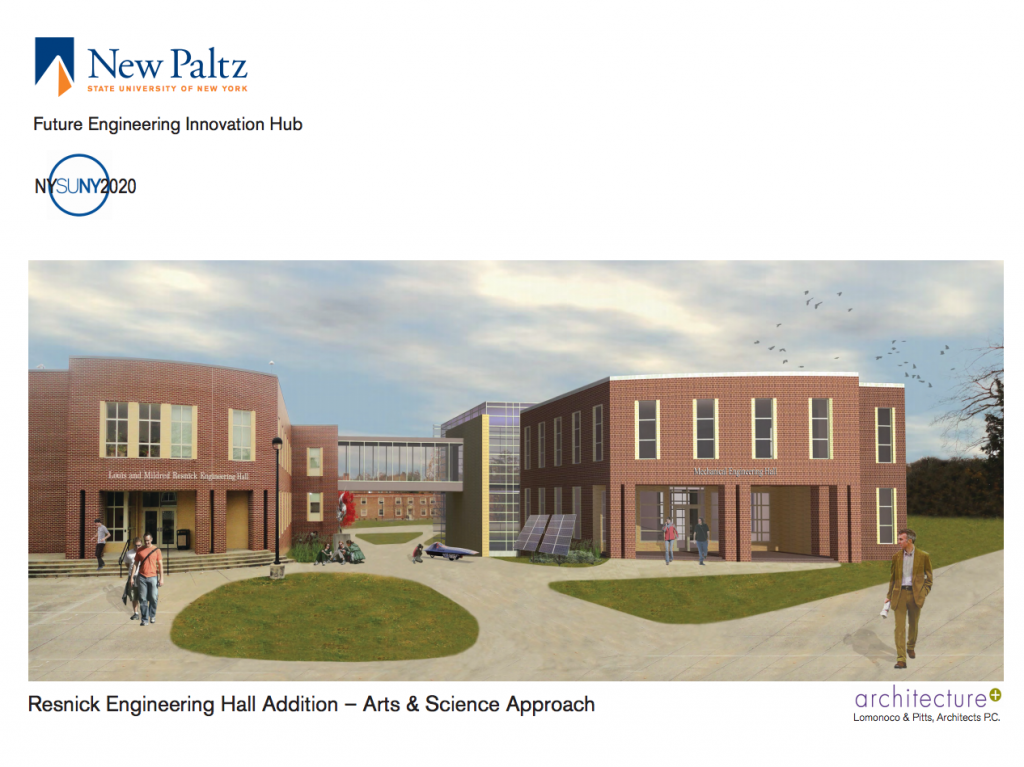
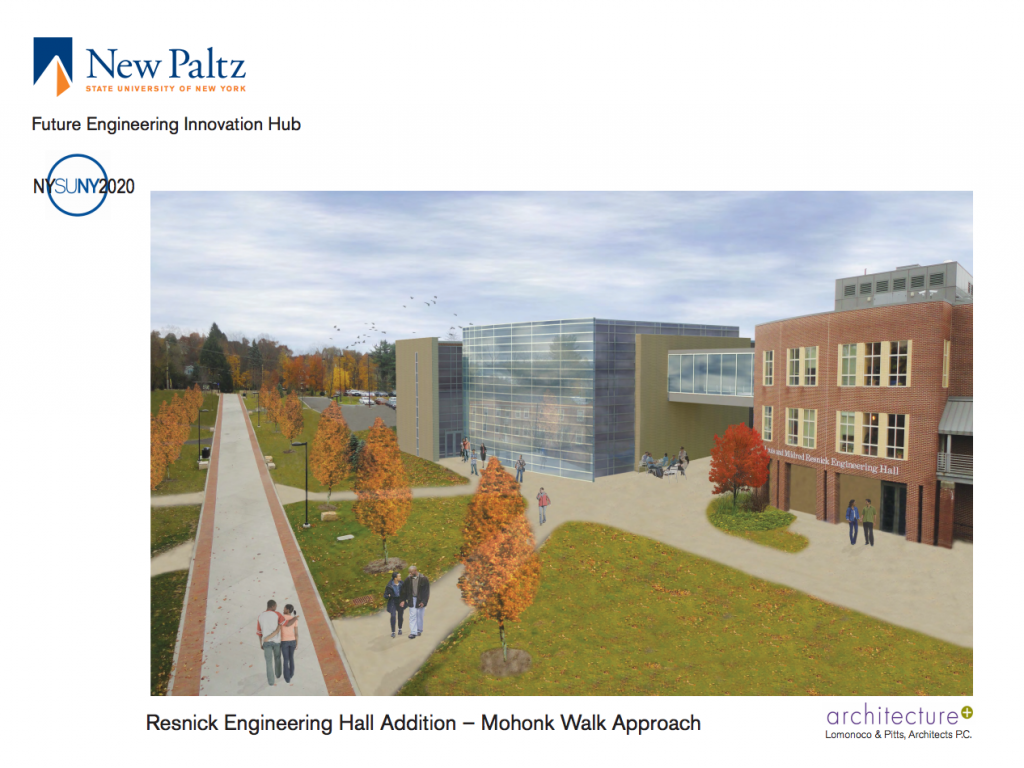
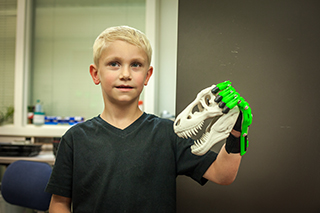
 New Paltz celebrated the opening of the nation’s first MakerBot Innovation Center with a press event and ribbon-cutting ceremony on Tuesday, Feb. 11. More than 100 people, including members of the business community, students, faculty and staff, attended the event, which was followed by a lecture by MakerBot CEO Bre Pettis.
New Paltz celebrated the opening of the nation’s first MakerBot Innovation Center with a press event and ribbon-cutting ceremony on Tuesday, Feb. 11. More than 100 people, including members of the business community, students, faculty and staff, attended the event, which was followed by a lecture by MakerBot CEO Bre Pettis.










